How does a dishwasher work?
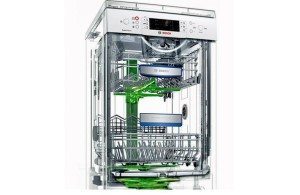 A dishwasher is one of the most complex household appliances. Although its device resembles that of a washing machine, it has a lot of differences and features. Knowledge of these features will allow you not only to choose the best unit from a technical point of view, but also in the event of a breakdown, not to contact a specialist, but to try to fix the problem yourself. What a dishwasher consists of, what are its main components, how the design of one dishwasher differs from another, and finally, how it works - we will tell you about all this.
A dishwasher is one of the most complex household appliances. Although its device resembles that of a washing machine, it has a lot of differences and features. Knowledge of these features will allow you not only to choose the best unit from a technical point of view, but also in the event of a breakdown, not to contact a specialist, but to try to fix the problem yourself. What a dishwasher consists of, what are its main components, how the design of one dishwasher differs from another, and finally, how it works - we will tell you about all this.
Main design elements
If you look into the structure of a dishwasher of any brand (Bosch, Ariston, Electrolux), removing the body and tray, you can see the following main components and elements:
- Motor - starts the internal components of the machine.
- The main (circulation) pump is the “heart” of the dishwasher. Responsible for supplying water from the water intake to the sprinklers (rocker arms).
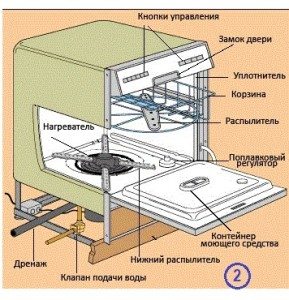
- Instantaneous water heater - installed in one housing together with the main pump, used to heat water.
- Drainage pump – provides drainage of waste water.
- Drain hose and pipes.
- Inlet hose with leakage protection device.
- A coarse filter, located at the inlet hose inside the machine, traps rust and other dirt contained in the water.
- Pressostat is a sensor that determines the water level (pressure) in the dishwasher.
- Water intake.
- Ion exchanger – a reservoir with resin for water softening.
- The control board is the electronic “brains” of the dishwasher, controlling the operation of all its “organs”.
- Connecting hoses, clamps and electrical wires.
- Noise insulation.
The following elements are visible from the side of the dishwasher tank:
- stainless steel tank;
- sprinklers (upper and lower);
- baskets for dishes and a tray for cutlery;
- filters - one in the form of a glass with a fine mesh, located in the bottom of the dishwasher, the second filter is a fine mesh located on top of the first filter;
- compartment for pouring salt;
- containers for detergents located on the door;
- rubber seal along the contour of the tank;
- control Panel.
Differences in the design of different dishwashers
The elements listed above form the simplest dishwasher device, but in fact, different models may differ in the presence of certain elements. These elements include: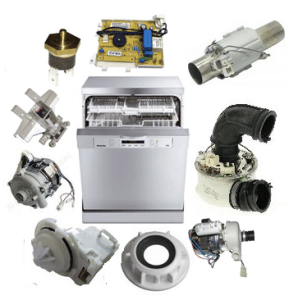
- The heat exchanger is a wide, flat plastic reservoir of cold water located inside the dishwasher, next to the metal tank. The presence of a heat exchanger ensures efficient drying without energy consumption.
- Fan and additional heating element for organizing turbo drying. With this type of drying, dishes dry very quickly, but it is not found in all models, for example, we did not find Bosch dishwashers with turbo drying, but Ariston machines (model LST 216 A and model LSF 712) have it.
- A sensor that determines the purity of water. Thanks to this sensor, the dishwasher automatically selects the washing program (temperature, amount of water, detergent).
- Sensors for the presence of salt and rinse aid, and a compartment for a 3-in-1 tablet. Present in many modern models.
- Drying sensor (Sensor Dry). This is modern intelligent drying technology, used in expensive dishwashers, for example, Miele G4263Vi.The drying sensor detects the ambient temperature in the room, relative to which the machine determines how to dry the dishes.
- A reservoir with mineral – it is necessary for organizing drying.
Zeolite is used as a mineral, which, when absorbing moisture, is capable of releasing dry heat. This technology is implemented in dishwashers from the Bosch and Neff brands.
- Sensor for automatic determination of water hardness and selection of a program in accordance with the indicator. This sensor is only built into very expensive dishwasher models.
- Program end sensor and time projection on the floor. A red “beam on the floor”, informing about the end of the wash, is built into all the latest models of machines, but a sensor showing the progress of the program and the remaining time on the floor is found in Bosch and Siemens machines.
- Holder for glasses and sprayer for washing baking trays. In some models they are included in the package, in some you need to buy them separately, and in others they are not provided at all.
In addition, dishwashers differ in size (small, narrow, large), the number of rocker arms (2 or 3), the metal used to make these rocker arms, and the design of the baskets. The baskets can vary in height (technology implemented by Bosch) and have folding elements. In addition, the dishwasher device may differ in software, but this topic is worth discussing separately.
Dishwasher operating stages
Now let's figure out how a dishwasher works, how all the components and elements we have listed interact. After you have loaded the dishes into the baskets, closed the door and selected the program, the machine begins to draw cold water (if there is no connection to hot water) through the inlet hose and valve.The water then enters the ion exchanger, where it is softened by sodium ions and resin, and then passes into the water collector located at the bottom of the dishwasher.
After some time, based on a signal from the pressure switch, which determines the level of collected water, the pressure switch is activated. The water supply valve closes and the heating element comes into operation. As soon as the water reaches the set temperature, the circulation pump turns on and, under pressure, directs the water to the rocker arms, which begin to rotate.
Important! When choosing a dishwasher, be sure to pay attention to the shape of the rocker arms and nozzle (hole). The more holes the better. And they should also have different shapes and be located at different angles, then the water jets will reach all areas of the chamber.
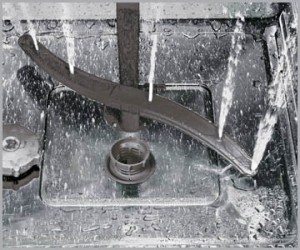 The water that gets into the tank flows down the walls to the bottom of the machine and through the filter again enters the water reservoir for reuse. At the same stage, the water is saturated with detergent from the compartment and again “enters” the chamber through the rocker arms. This completes the first washing cycle, and the drain pump turns on, pumping out waste water. Clean water is then drawn in for a cold rinse cycle.
The water that gets into the tank flows down the walls to the bottom of the machine and through the filter again enters the water reservoir for reuse. At the same stage, the water is saturated with detergent from the compartment and again “enters” the chamber through the rocker arms. This completes the first washing cycle, and the drain pump turns on, pumping out waste water. Clean water is then drawn in for a cold rinse cycle.
The second time, clean water is collected for the last rinse with warm water, which contains the rinse aid. At the end of this stage, the machine drains all waste water, and moisture begins to evaporate from the heated plates either naturally (condensation drying) or under the influence of forced hot air (turbo drying). Completion of the process is accompanied by a sound signal. The entire process of operating a dishwasher can take from 30 to 180 minutes, depending on the mode, details of which can be read in the article How long does it take for a dishwasher to clean?.
To summarize, we note that details about the design of your Bosch, Ariston or other dishwasher can be found in the instructions. In general terms, we tried to describe how a dishwasher works and what devices are included in its design.
Interesting:
Reader comments
- Share your opinion - leave a comment

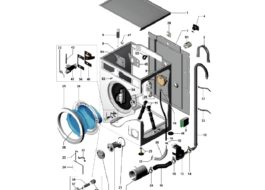
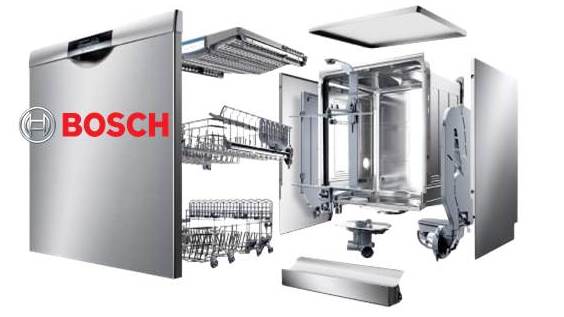

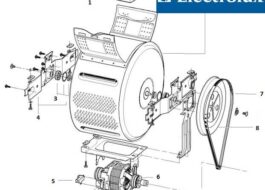
















Add a comment